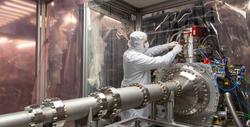European XFEL user operation restart
Remote participation to be the routine
European XFEL has started the user-experiments of the second run in 2020. Fewer users than usual will be on-site, with a majority participating in the experiments remotely. The new run will provide about 960 hours of beamtime for the users. In previous runs, around 30 experiments were usually scheduled. But due to COVID-19-related restrictions, only 16 experiments, including rapid access COVID-19-related research, are slated for the run.
Nevertheless, as usual, the selected experiments will cover a wide range of topics, some of which will directly address societal challenges such as a study geared to examining environmental-friendly crop-protection options, namely determining the structure of bacterial insecticides; gaining deeper insights into vitamins important for metabolism such as Coenzyme B12 by understanding the ultrafast changes its electronic structure; and COVID-19-related experiments. All six European XFEL instruments will be in operation.
Although there were no users on-site in the recent months, European XFEL staff and support groups have been busy working on the instruments. They worked on commissioning and upgrades to make experiments more user friendly and improve the performance of the facility and the service provided to users, all while adhering to the social distancing, mask and hygiene measures in place due to the COVID-19 situation.
Upgrades were carried out for detector calibration, data acquisition pipelines, instrument control, data analysis and visualization software. “This work is crucial for the facility, and we will benefit from it for years to come regardless of whether we shift to a more remote user participation mode or slowly open up for on-site user presence,” says Sakura Pascarelli, Scientific Director at European XFEL.
Remote user participation and working within the boundaries of the restrictions comes with its own set of challenges. “Remote participation requires much more preparation than just setting up video or web conferencing tools to ‘follow’ experiments remotely,” Pascarelli points out. “The user must be ‘in command’ of what’s going on throughout the experiment.” This means continuous communications with users who are not on site, who might be in different time zones, and over a number of days. It also means providing access to data and analysis software and arranging to view the detector images live. “The local presence of users is important especially when unexpected results are obtained, when observations deviate from predictions and decisions on how to go ahead need to be taken quickly,” she explains.
There is a lot the scientific community will have to reflect on. Pascarelli believes that science and scientists in general, across all fields, will come out of this crisis strengthened. “Together with the community, we are learning on how to cope with this unusual situation. We take one day at the time and one new challenge at the time,” she says.

